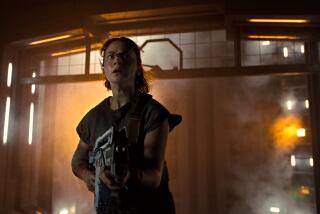Review: John Cho, Haley Lu Richardson tour buildings and emotions in the quietly captivating âColumbusâ
In one of the many conversations that animate âColumbus,â a serenely intelligent first feature from the Korean American writer-director Kogonada, a part-time librarian named Casey (Haley Lu Richardson) and her co-worker Gabriel (Rory Culkin) discuss a tricky double standard. As Gabriel notes, someone who loves video games but finds books boring is criticized for having a short attention span, while someone with the opposite inclination is praised for having a long one. âItâs not a matter of attention span, but of interest,â he says. âAre we losing interest in things that matter?â
Mercifully, he does not go on to extol the importance of gentle, gorgeously contemplative independent films like this one, though by that point âColumbusâ has already made the case in much more delicate and persuasive terms. With its quotidian rhythms, gossamer-thin story and steady accumulation of visual wonders, the movie may indeed test the limits of your attention span at times, but always in the interests of expanding your vision and clarifying your perceptions. If you find yourself losing interest, you have only yourself to blame.
The story follows two lonely, lovely young strangers, Casey and Jin (John Cho), who strike up a friendship over several days spent walking and talking their way around Columbus, Ind. That city has attracted renewed publicity over the past year as the hometown of Vice President Mike Pence, but it intrigues Kogonada and his characters for reasons that are more aesthetic than political.
Columbus has long been celebrated as an improbable enclave of Midwestern modernism, a public showcase for the splendors of Eero Saarinen, I.M. Pei and other leading architects. The cityâs wondrous, slightly incongruous design holds a particular fascination for Casey, a recent high-school graduate who lives with her mother (Michelle Forbes), a recovering drug addict. Jin, a book translator in his mid-30s who lives in Seoul, has flown in to visit his sick father (Joseph Anthony Foronda), a renowned architecture scholar who suddenly collapsed while touring the city.
Casey takes care of her mother with a level of devotion that, as some acquaintances are not too polite to point out, is holding her back from her own personal ambitions. Jin, meanwhile, hasnât spoken to his father in more than a year, and the old manâs condition looks serious enough that he might never get the chance. For Casey, beautiful buildings have been an inspiration and an escape from the troubles of real life; for Jin, they have been a source of indifference and resentment, a reminder of a parent who paid more attention to his vocation than to his child.
Whatâs remarkable about this wondrously assured debut is that technique never overwhelms feeling.
These sharp contrasts in filial devotion and personal passion define the characters as starkly as their more obvious gender and cultural differences, but they also lend the story a precise, pleasingly low-key symmetry. (The sounding-board character of Gabriel is matched on Jinâs side by Eleanor, a longtime friend and associate of his fatherâs, terrifically played by Parker Posey.) Weâre watching a story about two people who have tried, in very different ways, to avoid the burden of pain, even as shifting circumstances force them both to reconsider their definitions of home.
Symmetry, of course, can double as both a narrative conceit and an architectural ideal, and one of the pleasures of âColumbusâ is its structural sophistication, the way it sculpts its slender, entirely believable almost-love story into a dramatic shape that feels at once concrete and elusive. Kogonadaâs precise, measured editing offers the cinematic equivalent of clean lines and polished edges. The images, beautifully lit and meticulously composed by Elisha Christian, play ingenious tricks with depth, focus and perspective, framing Jin and Casey not just against stunning buildings, but also through doorways, down corridors and even from the backseat of a car.
Richardson, so warmly engaging in movies like âThe Edge of Seventeenâ and âThe Bronze,â and Cho, whose whip-smart charisma has long warranted more leading roles like this one, are so appealing that youâd gladly watch them in a movie with a less incisive sense of place. Few films are this sensitively attuned to their charactersâ dwelling spaces; fewer still can make those spaces feel as charged with meaning as the interactions that play out within them.
Kogonadaâs attention to visual form will come as little surprise to cinephiles who have seen his video essays analyzing the work of filmmakers including Stanley Kubrick, Robert Bresson, Yasujiro Ozu and Richard Linklater. (The latter two, with their blend of bittersweet intimacy and low-key formalism, feel like especially relevant influences here.) Whatâs remarkable about this wondrously assured debut is that technique never overwhelms feeling, in part because Kogonada makes the two seem inextricably, harmoniously linked.
âWhat moves you, particularly, about a building?â Jin asks Casey in one scene, after sheâs carefully laid out the history of the one-story glass structure that once housed Columbusâ Irwin Union Bank building. Itâs a pointed question; heâs trying to push her past a strictly intellectual response toward a more personal, human one. But âColumbusâ understands that thereâs less of a difference than we might think. It never lets you see where thinking ends and feeling begins.
------------
âColumbusâ
Not rated
(In English and Korean with English subtitles)
Running time: 1 hour, 44 minutes
Playing: Nuart Theatre, Los Angeles
More to Read
Only good movies
Get the Indie Focus newsletter, Mark Olsen's weekly guide to the world of cinema.
You may occasionally receive promotional content from the Los Angeles Times.











